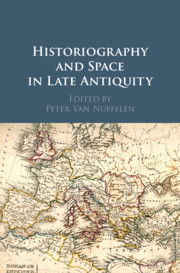Book contents
- Historiography and Space in Late Antiquity
- Historiography and Space in Late Antiquity
- Copyright page
- Contents
- Contributors
- Acknowledgements
- Introduction
- Chapter 1 Constantinople’s Belated Hegemony
- Chapter 2 Beside the Rim of the Ocean
- Chapter 3 Armenian Space in Late Antiquity
- Chapter 4 Narrative and Space in Christian Chronography
- Chapter 5 The Roman Empire in John of Ephesus’s Church History
- Chapter 6 Changing Geographies
- Chapter 7 Where Is Syriac Pilgrimage Literature in Late Antiquity?
- Bibliography
- Index
Chapter 2 - Beside the Rim of the Ocean
The Edges of the World in Fifth- and Sixth-Century Historiography
Published online by Cambridge University Press: 12 August 2019
- Historiography and Space in Late Antiquity
- Historiography and Space in Late Antiquity
- Copyright page
- Contents
- Contributors
- Acknowledgements
- Introduction
- Chapter 1 Constantinople’s Belated Hegemony
- Chapter 2 Beside the Rim of the Ocean
- Chapter 3 Armenian Space in Late Antiquity
- Chapter 4 Narrative and Space in Christian Chronography
- Chapter 5 The Roman Empire in John of Ephesus’s Church History
- Chapter 6 Changing Geographies
- Chapter 7 Where Is Syriac Pilgrimage Literature in Late Antiquity?
- Bibliography
- Index
Summary
In his panegyrical description of Hagia Sophia, delivered between 24 December 562 and 6 January 563, Paul the Silentiary praises Justinian for having domesticated seas and rivers. ‘These things’, he continues, ‘together with Western, Libyan, and Eastern triumphs, honour your power beside the rim of the Ocean’.1 This is reminiscent of the praise of Pseudo-Themistius for an emperor tentatively identified with Justinian.2 Such statements are topical, for imperial power was inherently universal: the claim to dominate the entire world is the spatial expression of the Roman Empire.3 As C. Nicolet has shown for Augustus, claims of world domination go hand in hand with claims to knowledge about that world.4
- Type
- Chapter
- Information
- Historiography and Space in Late Antiquity , pp. 36 - 56Publisher: Cambridge University PressPrint publication year: 2019
- 1
- Cited by

